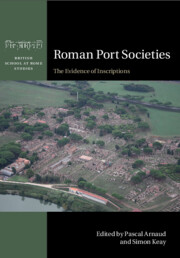Book contents
- Roman Port Societies
- British School at Rome Studies
- Roman Port Societies
- Copyright page
- Contents
- Figures
- Tables
- Contributors
- Abbreviations
- 1 The Context of Roman Mediterranean Port Societies
- 2 Inscriptions and Port Societies
- 3 Stationes and Associations of Merchants at Puteoli and Delos
- 4 Boatmen and their Corpora in the Great Ports of the Roman West (Second to Third Centuries AD)
- 5 Roman Port Societies and Their Collegia
- 6 Port Occupations and Social Hierarchies
- 7 Warehouse Societies
- 8 The Imperial Cult and the Sacred Bonds of Roman Overseas Commerce
- 9 Law and Life in Roman Harbours
- 10 Living Like a Cosmopolitan?
- 11 Ports, Trade and Supply Routes in Western Europe
- 12 The Port Society of Narona
- 13 Municipal Authority, Central Authority and Euergetists at Work at the Port
- 14 The Structure of Mercantile Communities in the Roman World
- 15 Polysemy, Epigraphic Habit and Social Legibility of Maritime Shippers
- 16 Reading Roman Port Societies
- Indexes
- References
16 - Reading Roman Port Societies
Published online by Cambridge University Press: 30 October 2020
- Roman Port Societies
- British School at Rome Studies
- Roman Port Societies
- Copyright page
- Contents
- Figures
- Tables
- Contributors
- Abbreviations
- 1 The Context of Roman Mediterranean Port Societies
- 2 Inscriptions and Port Societies
- 3 Stationes and Associations of Merchants at Puteoli and Delos
- 4 Boatmen and their Corpora in the Great Ports of the Roman West (Second to Third Centuries AD)
- 5 Roman Port Societies and Their Collegia
- 6 Port Occupations and Social Hierarchies
- 7 Warehouse Societies
- 8 The Imperial Cult and the Sacred Bonds of Roman Overseas Commerce
- 9 Law and Life in Roman Harbours
- 10 Living Like a Cosmopolitan?
- 11 Ports, Trade and Supply Routes in Western Europe
- 12 The Port Society of Narona
- 13 Municipal Authority, Central Authority and Euergetists at Work at the Port
- 14 The Structure of Mercantile Communities in the Roman World
- 15 Polysemy, Epigraphic Habit and Social Legibility of Maritime Shippers
- 16 Reading Roman Port Societies
- Indexes
- References
Summary
The excellent conference on which this volume has beenbased, ‘Roman Port Societies through the Evidence ofInscriptions’, made all of the participants reflectafresh on many fundamental questions about how thismedium illustrates the surprisingly elusive issue ofwhat kinds of societies were characteristic of Romanharbour settlements. These concluding remarks areintended to address some of these. Two very basicquestions about the medium stood out: how – and howfar – do surviving inscriptions actually reflectancient social history in the first place; and (inparticular) does the level of diversity in theepigraphic record mirror actual variety across timeand space in the Roman world?2 Romanports make rather good laboratory specimens for suchenquiries. The papers at the conference, inaccordance with the aims of the Portuslimen project, addressed a goodspread of ports, all, except Delos and Ephesos, fromthe western basin of the Mediterranean, principallyAquileia, Arelate, Hispalis, Lugdunum, Narbo,Narona, Ostia/Portus and Puteoli.
- Type
- Chapter
- Information
- Roman Port SocietiesThe Evidence of Inscriptions, pp. 425 - 443Publisher: Cambridge University PressPrint publication year: 2020



